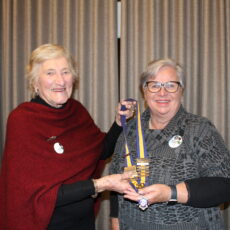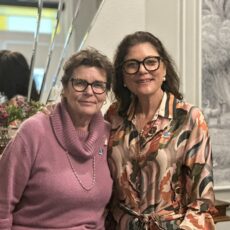Heading off to Florida to ferry back to Narrabri a new Piper M350 is the stuff of dreams.
And last month this dream came true for Narrabri resident Ken Flower.
Since 2010 Ken has conducted flight training for the Namoi Aero Club and has flown and trained in different parts of the world, but never before has he undertaken international flying.
Kicking off the adventure on April 21 from Narrabri to Tamworth in his Piper VH-CSB, Ken boarded commercial planes to Sydney, Dallas, and Orlando, followed by a hire car trip to Vero Beach, Florida.
The mission was to collect the brand new M350 at the Piper factory and deliver it to Narrabri.
Ken’s journey was tracked by his daughter Kat Denniss and followed by an enthralled audience.
Arriving at Vero Beach on Saturday, April 22, firstly for some relaxing and getting over jet lag, Monday was Ken’s first view of the Piper M350, confirming the huge progress in Piper planes from his first 1977 Piper Archer II – and he was pinching himself that it was real.
After a tour of the factory and despite continuing jetlag, Ken’s next step was to head into the simulator for some intensive training.
The training included five days of four hours of lectures and two-hour flights in the simulator.
The flights were out of Vero Beach, Florida flying to Melbourne, Florida, and comprised some steep turns, stalls, and slow flying, followed by avionics and emergencies.
Simulator flights continued with instructions on icing equipment – which entails flights into known icing conditions (FIKI).
The training was complex. It involved all facets of flying, problematical conditions and troubleshooting with an Advanced Aviation Training Device (AATD SIM), which included engine failure at 6000ft with a glide into either of two airfields.
With a final exam and flight test result of 92 per cent, we can safely say Ken passed with flying colours.
Ken was now qualified to fly the M350, including when it transitions to Australian registration.
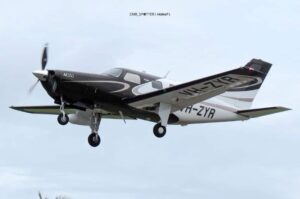
The Piper M350 in flight. Photo: Charith Madusanka and Haleef Ismail.
After a test flight, paperwork involving de-registration from the USA and re-registration in Australia was completed with a new registration number VH-ZYR.
Piper officials offered Ken a demonstration flight in a Pilot 100i training aircraft, and then preparations began for a departure date.
A must for a trip such as this one is an iridium phone connected to an international service.
After trials and tribulations it was discovered a ‘1’ was missing from the middle of a serial number for the Garmin GRS56 unit.
The problematical start was solved, and Ken now had worldwide phone service coverage direct to the plane, which you certainly cannot get in the 1977 model.
Checking that maps were all up to date for the Europe and Australasia sectors, completing various other checks and final tasks, and one last dinner at his favourite Thai noodle restaurant, Ken was ready to leave.
With an early start the next day, a brief look at weather patterns, plane fuelled and loaded, paperwork all sighted and signed, ferry pilot Stuart Caling’s arrival to accompany Ken on the trip – one thing remained at odds – there is still no sign of a life raft.
As fate would have it, the person who had said he would post the raft from Fort Lauderdale to Vero some weeks back, meant he would plan to do that.
With no raft, the trip could not start, so leg one of the flight path was now in the wrong direction.
A re-routed flight plan to pick the raft up was inconvenient but necessary.
Leg two became Fort Lauderdale to Boston, and Ken and Stuart were hoping for better winds than had been predicted.
They were not, and with 200 miles remaining there was a problem – the 57-knot head wind had reduced fuel range drastically to a 30-minute reserve.
Ken and Stuart pushed on, calculating and re-calculating where they should get fuel before heading on to Boston.
The pair ended up landing in Kingston, North Carolina for a fuel stop. Landing after dark and having picked the wrong night, the pilots had pretty limited options as the fixed base operator had closed up early.
They next had to find a place within range to land for the 53 gallons left on board.
The pair selected Norfolk, since it was an international airport, and they decided they could collect fuel plus immigration exit papers from the USA.
Staying overnight at Norfolk, then leaving before sun-up the next morning, the short flight past New York was impressive in the dawning sunlight.
“On this next leg we were heading to Boston, and enroute we got the plane satellite phone working and tested it, flying with the coast of New York to our left in the early morning sun, with a call to Australia,” said Ken.
“It is amazing that you can make a call, crystal clear, from up there in the clouds to absolutely anywhere.
“The good news was, now we had the three essential parts to the remote trip.
“A reliable plane with experience on fuel capability, a life raft, and a communication device which would work on every part of our journey.
“The trip went well, and we landed at Boston some hours later just before 9am.
“I fuelled up while Stuart organised customs and our flight plan for the next leg to Goose Bay.
“But then a new problem arose – Greenland was closed (yes airport, fuel, the lot) from 5pm Saturday until 6am Monday.
“We decided to stay on for one more night in Boston rather than one extra night in Goose Bay, Canada.
“This meant one day off and a full sleep that night, but we were now a day behind schedule.”
Flying from Boston to Goose Bay was cloudy with rain, sleet and snow predicted, and the pair were forced to fly through poor conditions.
The ice gear was working and there was ice building up on the leading edge of the wings.
“We broke out of cloud at around 600 feet (with a minimum of 430 feet) and landed well.
“But with 1.5m visibility we could not see the tower, but luckily the controller could see us on the ADS-B.
“The legal minimum visibility in USA is one mile, in Australia it is four kilometres.”
ADS-B (Automatic Dependent Surveillance Broadcast) is an air traffic surveillance technology that enables aircraft to be accurately tracked by air traffic controllers and other pilots without the need for conventional radar and visibility.
Ken continued, “We fuelled up in the snow and ordered de-icing for the plane at 3am the next day.
“It was a great day’s flying, with all the icing training I had been given used in practice, and I got to use it all in the one flight, which was amazing.”
A 2am wake-up was scheduled for the next morning, heading for Greenland, then to Iceland, Scotland, and Germany.
At 3.30am an external aircraft de-icing was needed.
“Possibly the first and last de-icing this plane will have in her life,” said Ken.
“The process is to spray on a warm glycol solution until all the ice is gone.
“This would usually use around 100 to 200 litres, costs around US$8 per litre, and lasts for only 30 minutes.
“So we had to warm the plane, shut down, get de-iced, and then as soon as that truck moved away, check with lights, start the engine and do not muck about! A costly but essential activity.
“We were headed for Greenland, and it was a 3.5hr flight mainly over water, with very large ice cubes floating in it.
“What an amazing sight it was.
“We landed in Greenland with a spectacular view, flying down the fjords to touch down at Narsaq Airport for a very quick toilet and fuel stop.
“Flying down into Greenland was breathtaking when we broke clear of cloud.
“The Fjords were impressive. I was conflicted, since I was in the wonderland of flying but with fjords there, I could not grab some snaps, so Stuart took over the controls and I was able to shoot a video,” Ken continued.
“When I resumed control to fly the approach in clear visual conditions, it was incredible how close (and I mean 200ft) the declared approach brings you to the mountains.
“It certainly focusses you to make sure that you will never break height minimums on an instrument approach procedure.
“Next, we departed Greenland for the 4hr flight to Iceland, which was also a spectacular flight over water with ice cubes diminishing in frequency.
“We landed at Reykjavik, Iceland just after 3pm. What a beautiful city on such a nice day, and the temperature was above zero.
“Interestingly Greenland was all ice and snow, and Iceland was all green grass – it seemed like someone got the names mixed up.
“A quick fuel and oil top up, and off again for Wick Airport in Scotland where we had organised customs and immigration.
“Landing was not without its hiccups, with airports in Scotland and Germany closed soon after our proposed ETAs, and not helped by us being one and a half hours behind schedule.
“While in the air, consideration had to be given to alternative airports.
“Wick airport was closed, so alternatives Glasgow and Edinburgh were planned for, but in the end air traffic sent us to Inverness airport instead for a quick fuel and coffee.
“The police there were very helpful since it was not a scheduled stop, and we were wheels up again at 9pm, heading for Kassel, Germany.
“Kassel airport closed at midnight, and we had to think about our next step with very worn-out brains.
“However, this time the air controller was very helpful and suggested Paderborn.
“He offered to call them to see if they were open and if they had customs open – and we were relieved to hear that they did.”
But pitfalls did not end there.
“At around 2am we cleared customs at Paderborn and walked to the airport hotel – but it was locked up.
“We headed back to departures and thankfully, a lady at the information desk rang the hotel and found the system for very late arrivals.
“She took a copy of my passport, gave me a code for the front door at the hotel, and told me where to find the room number and key.
“We got to bed after 3am and set the alarm for 6am, since we had already delayed a plane service which was due at Kassel, and they had informed us that we had to be sure to be there by 8am or we would have to re-book. Life was not meant to be easy!
“After more than 14 hours flying, seven hours in transits, landing in four countries, with less than three hours sleep that night, it was a tough call, but without a 50-hour service the plane would be grounded.
“Which would then result in a few days holiday in Germany, plus all of our other immigration and customs stops would have to be changed.
“So the next day we were up at 6am to fly the short 30-minute leg to Kassel, and the 50 hourly service was carried out with German precision.
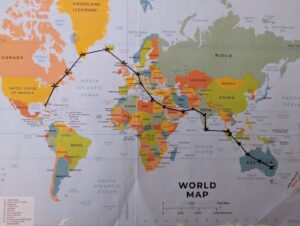
The route map for the Piper M350 showing the planned flight path.
“The next day we headed off to Egelsbach airport at Frankfurt, to pick up documents from the Australian Embassy needed for Asian documentation. Then we flew on to Crete.
“After eating three meals a day of our supplies of water, peanuts, carrots and muesli bars in the plane, we relished any proper meal or snack from then on.
“Our next flight down over the alps ran into some strong headwinds and icing, so we had plenty more practice with the de-ice gear.
“With everything running and drawing about 110 amps from the two
alternators, it worked a treat.
“But the ice was tenacious, was slowing us down, and burning a mass of fuel.
“Late into the trip the fuel calculations were intense and irregular – yes, ok, no, not ok – etc.
“By midnight we decided that we needed a top up, and the best spot being Athens, we stopped there for a ‘technical stop’ to refuel.
“Taking off again for Crete, finally we landed and got to bed at long last.
“But it was 3am in the morning and again, a 6am wakeup call was ordered.”
Despite the early wakeup call the next day, Ken and Stuart found they could not head off to Jordan as planned, as their entry permit was scheduled for the following day.
“Great, a day on the ground, and what a place to get stuck! We were in a room fronting the beach on a Greek Island in Crete.”
On May 12, the pair departed for Iraklion Airport in Crete for a quick diversion around Israeli air space, and yet another fuel stop in Aqaba, Jordan, then onto Al Ain, United Arab Emirates.
In Al Ain they had the luxury of not only a full night’s sleep, but an evening meal and a sit-down breakfast at 7am.
“We fuelled up and departed Al Ain at 9am the next morning for the longest single track yet, direct to Nagpur India. We landed at 6pm.
“Then we had to spend the next three and a half hours fuelling via drums of avgas which had been trucked in from 300km away, and as a consequence spent plenty of time with Indian officials.
“Eventually, when we said we would just sleep there at the airport, they decided to stamp our documents and we were off to a very nice hotel.
“Sunday saw us with a 4am wakeup call and wheels up at 5.20am at Nagpur heading for Colombo, Sri Lanka, where drum fuel had again been arranged.
“The very pleasant team at Colombo met us and we completed customs and immigration plus had a local group taking pictures of our every move and posting to social media.
“It was a very nice, albeit short stay with very helpful locals.
“11.06am saw wheels up at Colombo for the long track across the Bay of Bengal.
“Nothing but water and ships below us, and a large cyclone system to the north wreaking havoc on the cities around the top of the bay.
“We landed in Banda Aceh, Indonesia for a very fast and unplanned fuel stop, and then headed off to Singapore.
“Again we were diverted, this time to Kuala Lumpur, since Singapore airport was closed.
“We landed at Sabang airport at 9.45am for an overnight stay.
“On May 15, with wheels up again at Kuala Lumpur headed for Singapore, we set off to spend the night with friends at the Wings Over Asia Flying Club (WOA).
“We enjoyed a nice day there and plenty of members arrived to chat and see the plane.”
The Piper M350 was now en-route from Singapore. After one more stop in Bali Indonesia, the pair finally landed around 6.30pm on home turf in Broome, clearing customs and immigration with a complete check-over.
“The following day the next leg of the journey took us across Australia, firstly landing at Alice Springs for fuel.”
In Alice Springs, Ken caught up with his good friend Joris Van der Hiejden who was a former flight instructor with Namoi Aviation, and is now piloting for the Royal Flying Doctor Service.
“Then onto Brisbane was the plan, but due to severe turbulence at 20,000 feet to 30,000 feet, we had to drop from 25,000 feet to 19,000 feet.
“The wind was not good, and a top-up of fuel was necessary at Toowoomba before flying on to Archerfield, Brisbane overnight.
“Thursday, May 18 was spent organising the regulatory work to complete finalisation of registration on Australian soil, and then finally, we were heading home to Narrabri.”
The exciting arrival home at Narrabri airport was a day of celebration for Ken’s family, wife Sue, son Andrew, daughter Kat, son-in-law Jason, and grandchildren Laura, Nathan, Elspeth, Nash and Savanna.
Fellow pilots and friends joined the family at the airport to greet Ken and Stuart as they touched down.
“I wish to thank my family and friends for helping me make this trip of a lifetime,” said Ken.
“Especially my daughter Kat and my wife Sue for keeping everyone following my flight informed.
“I take my hat off to Stuart Caling of Global Ferry Services who does this so professionally for a living.
“My co-pilot has taught me so much and has become a friend, and I thank him for that.
“The great thing about the flight was all the different people at the 18 different countries we landed at.
“It is great that we are all different, and amazing how different we all are, but the friendship and assistance you get across all groups is a bonding human trait.
“Having been to all these places over an 11-day period, I value more than ever the great community, lifestyle, and airport we have here in Narrabri.”
It was four weeks ago when the family had farewelled their beloved husband, father and pop, following with trepidation and excitement a journey that was tumultuous, heart-stopping and conclusively, the ultimate triumph.
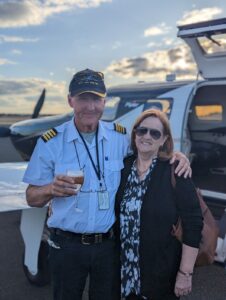
Ken and Sue Flower.








